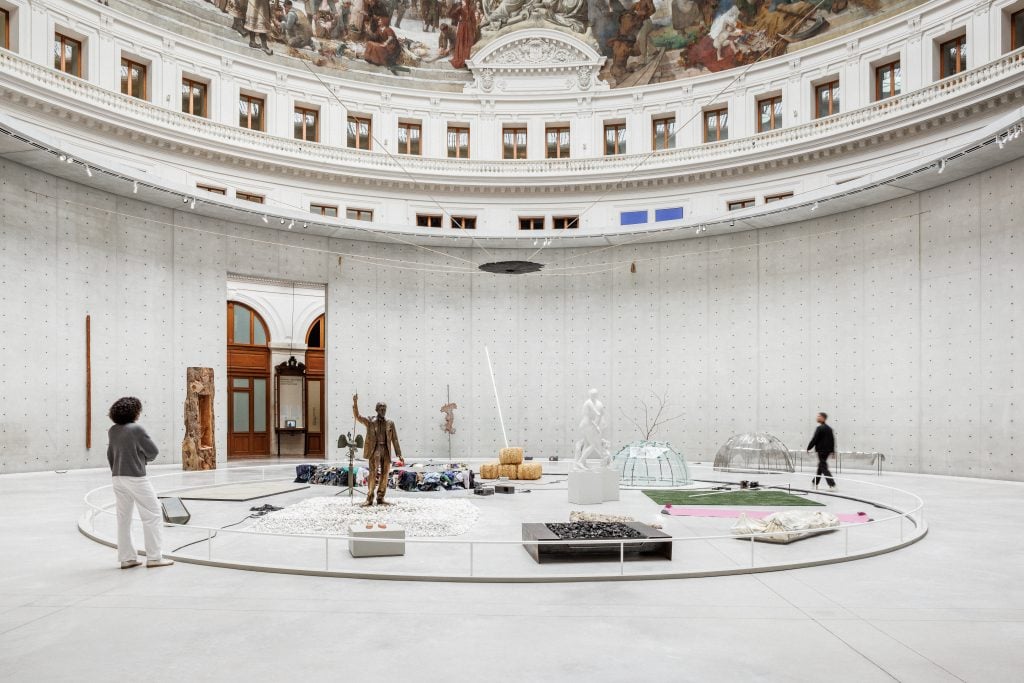Art Fairs
With a Blockbuster Arte Povera Show in Town, Dealers at Art Basel Paris Cash In on Famously Hard-to-Sell Movement
The celebrated Italian artistic era—deeply focused on ephemeral materials—is neither cheap nor easy to acquire.

Art dealers at Art Basel Paris are seizing the opportunity to bring several historic Arte Povera works to the fair, plus ‘post-Arte Povera’ creations influenced by them. The fair opens this week in the French capital at the Grand Palais.
With a major Arte Povera exhibition at the Bourse de Commerce, Pinault Collection in Paris, the niche, postwar Italian conceptual art movement of the late 1960s and 1970s, is in the spotlight, enjoying some overdue, wider recognition.
It’s a noticeable shift for the historic, anti-establishment movement that famously favored ephemeral and difficult-to-move, and simple materials, that were not made with a commercial gallery space in mind. And while cherished by institutions, Arte Povera draws a dedicated, but limited following of connoisseurs, rather than a broader art-collecting public.
For one, it doesn’t look great on Instagram. It doesn’t have the shimmer of Pop or Minimalism, made commercial successes in the US and northern Europe.
“When you’re buying these pieces, you really need to understand that you appreciate mainly the idea behind the work, which is more important than keeping them in a pristine condition due to the use of more ephemeral materials. And to be honest, that excludes already a quite large part of buyers,” said Ellen De Schepper, an advisor at the Association of Professional Art Advisors (APAA). “The art historical importance is so much more important in these pieces than the market value.”
The winds may be shifting, however, even if only slightly.

Cardi Gallery. Courtesy Art Basel
“We’ve been besieged by people, and getting loads of interest,” said Senior Director Joe La Placa at Cardi Gallery, at Art Basel Paris on the VIP preview, Wednesday. He said the gallery immediately sold two large Jannis Kounellis sculptures made in 1994 to a Dutch museum by midday, offered at 300,000 euros ($326,000) each—on the higher end of price points for the artist, who remains undervalued. There are a few other Arte Povera pieces “that are definitely going to go,” he added.
Around the city, there are further shows in commercial spaces, both at Tornabuoni Art and Galleria Continua.
“Everyone is here, from all corners of the earth,” La Placa added. “While things might have been difficult in the past, this a turning point.” The gallery is also showing works by Arte Povera mainstays Michelangelo Pistoletto and Giulio Paolini. La Placa said such strong market interest in the movement, though stable over-all, “has not been the scenario over the last year. The beginning of the year was not bad, but it just kind of dropped off, and it’s going to pick up. I’m very optimistic.”
Alighiero Boetti stands out as the movement’s market-friendly darling, whose famous, embroidered “Mappa” series set a record for the movement when a piece sold for $8.83 million at Sotheby’s in 2022. One such “Mappa” piece of his, made in 1989-91, covers the entire, large wall at Tornibuoni Art’s booth at the fair. It was sold by early morning on preview day, after being reserved in advance. The gallery could not share the price. To make these vibrant pieces, Boetti commissioned Afghan women embroiderers to weave shapes and colors of flags on a world map that changed according to the geopolitics of the day.

Installation view of the exhibition “Arte Povera,” Bourse de Commerce – Pinault Collection, Paris, 2024. © Tadao Ando Architect & Associates, Niney et Marca Architectes, agence Pierre-Antoine Gatier. Photo : Florent Michel / 11h45 / Pinault Collection.
In tumultuous times, Arte Povera would appear well-positioned from a sales standpoint, given the current market slowdown. “I think that a lot of people feel a lot more comfortable knowing that they’re buying a historically interesting piece that has a price that reflects the importance, but not the craziness of the markets,” said De Schepper. “In times where the market moves slower, it is always these historically significant categories that shine more than the others,” she added.
Still, others, including advisor Hailey Widrig at APAA, noted collectors who tend to be interested in Arte Povera are less involved with speculative acquisitions to begin with, meaning the market changes have less of an impact on what works they want to acquire. All in all, De Schepper nevertheless said she “didn’t expect any drastic changes” to the movement’s market.
That was also evidenced at the fair, where despite reported interest, dealers said there was still a lot of work to do in terms of sales, is in keeping with reports of slower transactions at fairs of late.
Galerie Karsten Greve, for its part, is showing more Kounellis works: two signature painting and collage pieces with black and white arrows, letters, crosses, and checkers. Speaking for the gallery, Mélanie Pourciel agreed the Bourse exhibit helped push the artist, “outside of this niche aspect he tended to have before. There is an enormous amount of connoisseurs who are coming especially to see these works, which they say they recognize immediately.” However, by late Wednesday, they had not been placed yet.
Similarly, at Lia Rumma an ambitious booth featured a large Gilberto Zorio sculpture made of leather skins and an electric cable that heats up, turns red, and lets off immediately apparent warmth. Installing the piece, offered for €700,000 to €800,000 ($760,000 to $868,000) in a home, however, is not a given, said gallery director Paola Potena.
“It’s not easy to live with them,” she said of Arte Povera, citing their fragility, and that they are not necessarily “pleasant.” Museums are often better suited to take them on. The gallery is also showing a Michelangelo Pistoletto mirror piece dated between 1962 and 2009, for €1.8 million ($1.95 million). It depicts a noose on the mirror’s surface, hanging at eye level, so that as you walk up to it, it looks as though it is hanging around your neck.
That said, Arte Povera pieces can also help round out a collection. “If you’re looking to counterbalance more commercial works, for instance, when you add Arte Povera [to a collection], you’re adding something intellectually significant,” said De Schepper.





